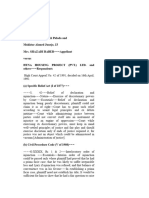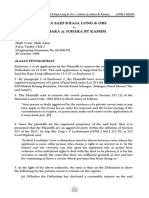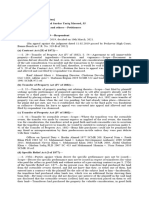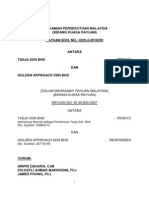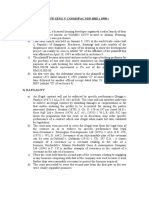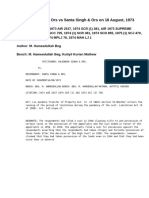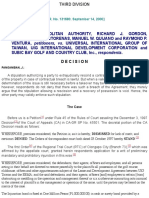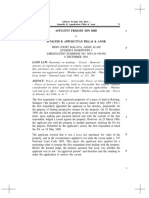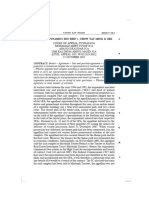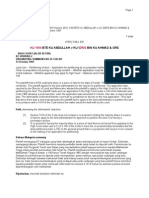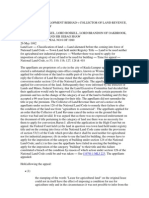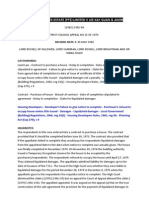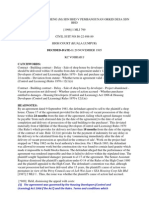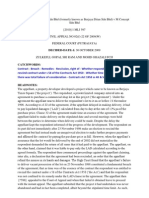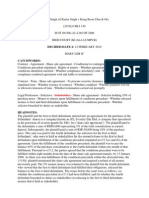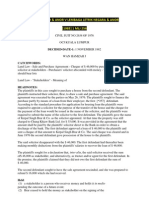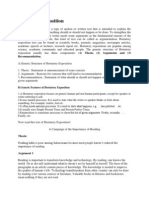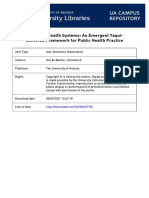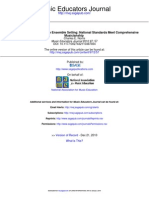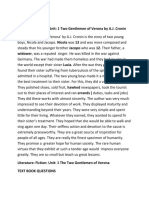Case Infra Elite V Pacific Treasure
Case Infra Elite V Pacific Treasure
Uploaded by
Iqram MeonCopyright:
Available Formats
Case Infra Elite V Pacific Treasure
Case Infra Elite V Pacific Treasure
Uploaded by
Iqram MeonOriginal Title
Copyright
Available Formats
Share this document
Did you find this document useful?
Is this content inappropriate?
Copyright:
Available Formats
Case Infra Elite V Pacific Treasure
Case Infra Elite V Pacific Treasure
Uploaded by
Iqram MeonCopyright:
Available Formats
INFRA ELITE DEVELOPMENT SDN BHD v PACIFIC TREASURE LAND SDN BHD [2002] 6 MLJ 545 ORIGINATING SUMMONS
NO 24-1863 OF 2001 HIGH COURT (PULAU PINANG) DECIDED-DATE-1: 27 SEPTEMBER 2002 KAMALANATHAN RATNAM J CATCHWORDS: Civil Procedure - Damages - Assessment of damages - Application for removal of private caveat - Whether plaintiff had to set out particulars of loss and damage in affidavit in support of application - Whether particulars of loss and damage need only be proved at the hearing of the assessment before the senior assistant registrar Civil Procedure - Originating summons - Intituling of originating summons - Plaintiff relied on s 327 of the National Land Code 1965 in intitulement - Whether plaintiff could fall back on s 329(1) of the National Land Code 1965 to claim damages Land Law - Restraint on dealings - Caveats - Application for entry of caveat by defendant expressed to bind entire land when defendant's interest was only in the right to construct monsoon drain on land - Defendant did not restrict effect of caveat to bind particular interest claimed - Whether this was a deliberate act on the part of the defendant - Whether there was wrongful entry of caveat by defendant Statutory Interpretation - Construction of statutes - Purposive approach - Construction of s 327 of the National Land Code 1965 - Whether the words the court (acting, if the circumstances so require, ex parte) may make such order on the application as it may think just in s 327 envisaged the making of an order for damages and costs for the successful applicant - Intention of legislature HEADNOTES: The plaintiff was the purchaser of a piece of land in Daerah Seberang Prai Tengah, Pulau Pinang (the said land), having fully paid the purchase price to the vendor. The plaintiff was unable to register itself as the owner of the said land because the defendant had entered a caveat over the said land (the said caveat). The Application For Entry of a Private Caveat or Form 19B of the National Land Code 1965 (NLC) which the defendant was required to submit pursuant to s 323 of the NLC showed that the caveat was to bind the entire land itself and not any particular interest. The ground pursuant to which the defendant sought to enter the caveat was that the plaintiff had allowed the defendant to construct a six foot wide monsoon drain on the plaintiff's land. The plaintiff took out an originating summons on 1 November 2001 for the orders that: (a) the defendant vacate and cancel the caveat forthwith;
(b) the Registrar of the Land Office, Seberang Prai or any other authorized officer do cancel the caveat forthwith; (c) the senior assistant registrar assess the damages suffered by the plaintiff as a result of the wrongful entry of the caveat and that the defendant pay the assessed damages to the plaintiff; (d) the defendant be prevented from entering any private caveat over the said land; and (e) costs. The defendant withdrew the said caveat on 6 May 2002 and thereafter entered a fresh caveat over that portion of the said [*545] land upon which the monsoon drain would be constructed. Upon the withdrawal of the said caveat, the plaintiff sought damages for the period of time the said land was wrongfully caveated.
Held: (1) In this case, the plaintiff had moved the court pursuant to s 327 of the NLC as it was the only recourse available to a caveatee who was aggrieved by the existence of a private caveat. Although s 327 was silent as to the consequence if the caveatee succeeded, it did not mean that the successful caveatee would be deprived of the fruits of its success and not be entitled to damages and costs. This was not the intention of the legislature. The words the court (acting, if the circumstances so require, ex parte) may make such order on the application as it may think just in s 327 clearly envisaged the making of an order for damages and costs. This was where the courts must apply the purposive approach to legislative interpretation. Accordingly, s 329 of the NLC need not have been invoked in this case for the court to grant damages (see pp 553H-554A, G). (2) The defendant argued that since the plaintiff only relied on s 327 of the NLC in the intitulement, it could not fall back on s 329(1) of the NLC to claim damages because s 327 was silent on the award of damages. By not intituling reliance on s 329(1) of the NLC , it did not mean that the plaintiff was not entitled to the relief under s 329(1) of the NLC . Further, the parties had committed themselves to full submissions on both ss 327(1) and 329(1) of the NLC (see pp 551H, 555H). (3) The application for entry of a caveat which was filed by the defendant was expressed to bind the entire piece of land, even though the defendant's alleged interest was only in the right to construct the monsoon drain on the said land. Nowhere in the application to enter the caveat did the defendant restrict the effect of the caveat to bind that particular interest claimed. The defendant's conduct in caveating the whole land without limiting its effect when it knew that it was not entitled to do so, was a deliberate act on the part of the defendant and this wrongful act had infringed the plaintiff's rights. Accordingly, there had been a wrongful entry of the caveat by the defendant (see p 558C-E, H). (4) There was no necessity at this stage to set out the particulars of the
plaintiff's loss and damage in its affidavit. This was because the plaintiff's prayer was for a request that damages be assessed by the senior assistant registrar (SAR). Hence, the particulars of loss and damage need only be proved at the hearing of the assessment. The very fact that the plaintiff had sought the prayer as prayed for was a clear indication that the plaintiff would adduce [*546] further evidence in respect of this part of the claim before the SAR (see p 559D, H). (5) Even though the defendant had filed another suit for specific performance (the other suit) of the alleged agreement between the defendant and the plaintiff to allow the defendant to construct the monsoon drain, it was not necessary for the plaintiff to file a counterclaim or a summons in chambers in the other suit to remove the private caveat. It was the duty of the plaintiff to take the most expeditious course available to vindicate its rights and at the same time mitigate the damages to be paid by the defendant. The process by way of the instant originating summons was expeditious and the plaintiff was entitled to this speedier remedy. Accordingly, the defendant's claim of multiplicity of proceedings in this case was inappropriate (see pp 560C-D, I-561A), Cheng Chin Chong v Shak Heng & Sons Sdn Bhd [1982] 1 MLJ 160 distinguished (6) Order in terms of prayers (a), (b), (c) and (e) of the originating summons was granted. However, prayer (d) was disallowed as it would be wrong to restrain the defendant from entering a caveat if it felt that such an entry was warranted for whatever cause, so long as the defendant was able to justify it (see p 561C-D).
Bahasa Malaysia summary Plaintif merupakan pembeli sebidang tanah di Daerah Seberang Prai Tengah, Pulau Pinang (tanah tersebut), setelah membayar harga beli sepenuhnya kepada penjual. Plaintif tidak dapat mendaftar dirinya sebagai pemilik tanah tersebut kerana defendan telah memasukkan satu kaveat atas tanah tersebut (kaveat tersebut). Application For Entry of a Private Caveat atau Borang 19B Kanun Tanah Negara 1965 (KTN) yang perlu diisi oleh defendan menurut s 323 KTN menunjukkan bahawa kaveat tersebut adalah untuk mengikat seluruh tanah tersebut dan bukan sebarang kepentingan tertentu. Alasan di bawah mana defendan ingin memasukkan kaveat adalah bahawa plaintif membenarkan defendan membina sebuah parit monsoon selebar enam kaki atas tanah plaintif. Plaintif memfailkan satu saman pemula pada 1 November 2001 untuk perintah-perintah agar: (a) defendan mengosong dan membatal kaveat tersebut dengan serta-merta; (b) Pendaftar Jabatan Tanah, Seberang Prai atau manamana pegawai yang diberi kuasa membatal kaveat tersebut dengan serta-merta; (c) penolong kanan pendaftar mentaksir ganti rugi yang dialami oleh plaintif akibat kemasukan salah kaveat dan bahawa defendan bayar ganti rugi yang ditaksir kepada plaintif; (d) defendan dilarang daripada memasukkan sebarang kaveat persendirian atas tanah tersebut; dan (e) kos.
Defendan menarik balik kaveat tersebut pada 6 Mei 2002 dan selepas itu memasukkan kaveat baru ke atas bahagian tanah tersebut yang mana parit monsoon akan dibina. Atas penarikan balik kaveat tersebut, plaintif memohon ganti rugi [*547] untuk tempoh di mana tanah tersebut dengan salahnya dimasukkan kaveat.
Diputuskan: (1) Dalam kes ini, plaintif telah merayu kepada mahkamah menurut s 327 KTN kerana ia merupakan satu-satunya jalan yang terbuka kepada seorang penanggung kaveat yang terkilan oleh kewujudan kaveat persendirian. Walaupun s 327 tidak menyebut akibat sekiranya penanggung kaveat berjaya, ia tidak bermakna bahawa penanggung kaveat yang berjaya akan dilucutkan hasil kejayaannya dan tidak berhak menerima ganti rugi dan kos. Ini tidak merupakan hasrat badan perundangan. Perkataan-perkataan the court (acting, if the circumstances so require, ex parte) may make such order on the application as it may think just dalam s 327 jelas membayangkan perintah dibuat untuk ganti rugi dan kos. Inilah di mana mahkamah mesti memakai pendekatan yang menitikberatkan tujuan statut kepada tafsiran perundangan. Maka, s 329 KTN tidak perlu dipakai dalam kes ini untuk membolehkan mahkamah membenarkan ganti rugi (lihat ms 553H-554A, G). (2) Defendan telah berhujah bahawa oleh kerana plaintif hanya bergantung pada s 327 KTN dalam intitulement, ia tidak boleh bergantung pada s 329(1) KTN untuk menuntut ganti rugi kerana s 327 tidak menyebut apa-apa tentang award ganti rugi. Dengan tidak meletak harapan pada s 329(1) KTN, ia tidak bermakna bahawa plaintif tidak berhak mendapat relief di bawah s 329(1) KTN. Seterusnya, pihak-pihak terikat dengan janji kepada hujah penuh atas kedua-dua ss 327(1) dan 329(1) KTN (lihat ms 551H, 555H). (3) Permohonan untuk kemasukan kaveat yang difailkan oleh defendan dinyatakan sebagai mengikat seluruh bidang tanah, walaupun kepentingan defendan kononnya cuma di dalam hak untuk membina parit monsoon atas tanah tersebut. Defendan tidak mengatakan had kesan kaveat untuk mengikat kepentingan tertentu yang dituntut di dalam permohonan untuk memasukkan kaveat. Kelakuan defendan dalam mengkaveat seluruh tanah tersebut tanpa menghadkan kesannya sedangkan beliau sedar beliau tidak berhak membuat demikian merupakan satu tindakan yang sengaja pada pihak defendan dan perbuatan salah ini telah melanggar hak-hak plaintif. Oleh itu, telah berlakunya kemasukan kaveat secara salah oleh defendan (lihat ms 558C-E, H). (4) Tiada keperluan di peringkat ini untuk menyatakan butir-butir kerugian dan kerosakan kepada plaintif dalam afidavitnya. Ini adalah kerana permohonan plaintif adalah satu permintaan supaya ganti rugi ditaksir oleh penolong kanan pendaftar (PKP). Justeru itu, butir-butir
mengenai kerugian dan kerosakan cuma perlu dibuktikan di dalam pendengaran taksiran. Hakikat bahawa [*548] plaintif telah memohon sebagaimana yang dipohon jelas menunjukkan bahawa plaintif akan mengemukakan keterangan lanjut berhubung dengan bahagian tuntutan ini di hadapan PKP (lihat ms 559D, H). (5) Walaupun defendan telah memfailkan satu lagi guaman untuk pelaksanaan spesifik (guaman yang satu lagi) tentang perjanjian yang dikatakan di antara defendan dan plaintif untuk membenarkan defendan membina parit monsoon, plaintif tidak perlu memfailkan tuntutan balas atau saman dalam kamar dalam guaman yang satu lagi untuk membatalkan kaveat persendirian itu. Adalah kewajipan plaintif untuk mengambil jalan yang secepat mungkin untuk mewajarkan haknya dan pada masa yang sama mengurangkan ganti rugi yang harus dibayar oleh defendan. Proses menerusi saman pemula ini adalah pantas dan plaintif berhak menggunakan remedi yang lebih cepat ini. Oleh itu, dakwaan kegandaan prosiding oleh defendan dalam kes ini adalah tidak wajar (lihat ms 560C-D, I-561A); Cheng Chin Chong v Shak Heng & Sons Sdn Bhd [1982] 1 MLJ 160 dibeza. (6) Perintah seperti dipohon (a), (b), (c) dan (e) saman pemula dibenarkan. Walau bagaimanapun, permohonan (d) tidak dibenarkan kerana adalah salah untuk menahan defendan daripada memasukkan kaveat sekiranya beliau rasa kemasukan sedemikian adalah wajar untuk sebarang sebab, jikalau defendan dapat menjustifikasikannya (lihat ms 561C-D).] [ Editorial Note: The defendant filed an appeal in the Court of Appeal on 22 October 2002. No date of hearing has yet been fixed.] Notes For cases on assessment of damages, see 2 Mallal's Digest (4th Ed, 2001 Reissue) paras 19191927. For cases on intituling of originating summons, see 2 Mallal's Digest (4th Ed, 2001 Reissue) para 4092. For cases on caveats, see 8 Mallal's Digest (4th Ed, 2001 Reissue) paras 3015-3312. For cases on the purposive approach of statutory interpretation, see 11 Mallal's Digest (4th Ed, 1996 Reissue) paras 1538-1563.
Cases referred to Beca Developments Pty Ltd v Idameneo (No 92) Pty Ltd (1990) 21 NSWLR 459 Cheng Chin Chong v Shak Heng & Sons Sdn Bhd [1982] 1 MLJ 160 Ch'ng Sin Poey & Sons Bhd v Quek Lian Meng [1979] 1 MLJ 98 Chor Phaik Har v Farlim Properties Sdn Bhd [1994] 3 MLJ 345 Collingridge v Sontor Pty Ltd Matter No 3360/97 (29 October 1997) Young J
[*549] Lachaume v Broughton (1903) 3 SR (NSM 475); 20 WN (NSW) 161 Majlis Perbadanan Pulau Pinang v Lembaga Rayuan Negeri Pulau Pinang & Ors [2002] 3 AMR 3637 Sivarasa Rasiah v Badan Peguam Malaysia & Anor [2002] 2 MLJ 413 Terri Company Ltd v Aldoth Pty Ltd (1989) NTSC 3 Trans-Summit Sdn Bhd v Chun Nyiok Lin [1995] 3 MLJ 247 Woo Yok Wan v Loo Pek Chee [1975] 1 MLJ 156 Legislation referred to National Land Code ss 322, 323, (1), 325, 327, (1), 329, (1) Real Property Act 1900 [New Zealand] s 74P(1) Rules of the High Court 1980 O 1A, O 2 r 3
Raj Shanker (Rajasingam & Co) for the plaintiff. YC Wong (Lim Kean Siew & Co) for the defendant. KAMALANATHAN RATNAM J:: Facts [1] The plaintiff was the purchaser of Lot 1418 Mukim 14, Daerah Seberang Prai Tengah, Pulau Pinang, held under Geran Mukim No 816 (the land) having fully paid the purchase price to the vendor. The plaintiff was therefore the beneficial owner of the said land. The plaintiff was unable to register itself as the owner because the defendant had entered a caveat on 9 April 2001 over the said land. Form 19B which is the Application For Entry of a Private Caveat which the defendant was required to submit pursuant to s 323 of the National Land Code (the NLC) and which was exhibited showed that the caveat was sought to bind the entire land itself and not any particular interest described in the said schedule. The ground pursuant to which the defendant sought to enter the caveat and as stated in the Form 19B was that the plaintiff had allowed the defendant to construct a six foot wide RC monsoon drain (the said drain) on the plaintiff's land. [2] The plaintiff then took out an originating summons on 1 November 2001 for the following orders: (1) to vacate and cancel the caveat forthwith; (2) that the Registrar, Land Office, Seberang Prai or any other authorized officer do cancel the said caveat forthwith; (3) that the senior assistant registrar do assess the damages suffered by the plaintiff as a result of the wrongful entry of the caveat and that
the defendant do pay the assessed damages to the plaintiff; (4) that the defendant be prevented from entering a private caveat over the said land; (5) costs. [*550] Findings of the court [3] The plaintiff denied giving the defendant permission to construct the said drain on the plaintiff's land. The plaintiff further averred that it had not entered into any agreement with the defendant to enable the defendant to enter into the plaintiff's land and to construct the said drain. The plaintiff contended that the defendant had shown no valid or reasonable cause to entitle the defendant to enter the said caveat nor had it shown any valid power or authority to entitle it to enter the said caveat. The plaintiff further averred that in any case the defendant was not entitled to caveat the entire land of the plaintiff since the defendant had not claimed any interest over the entire land. The plaintiff also pointed out that in the event the defendant had a right as claimed to construct the said drain, the defendant was clearly not at liberty to caveat the entire land of the plaintiff. [4] Subsequently, an affidavit (encl 5) was filed by one Khor Siak Koon who stated in para 1 of the said affidavit that he is the director of the plaintiff and has been authorized by the plaintiff to affirm this affidavit. However upon a perusal of the contents of the affidavit and the jurat, I was surprised to note that the affidavit is in actual fact filed by the defendant's director and in response to the plaintiff's affidavit in support of the originating summons. How could the defendant's director contend that he can affirm an affidavit on behalf of the plaintiff and further to contend that he was authorized by the plaintiff to affirm that affidavit? Either this is a false affidavit or at best it was careless drafting. Since it was the solicitors who prepared the affidavit, I shall give the deponent the benefit of the doubt and hold that it was carelessness on the part of solicitors that caused this confusion and that it is not to be construed as a false affidavit. This case illustrates how important it is for solicitors to be precise and accurate in their drafting. In the circumstances, it is only proper to reject the contents of encl 5. [5] In the meantime, the defendant affirmed an affidavit through its director on 7 May 2002 (encl 10) in which the defendant admitted having withdrawn the said caveat on 6 May 2002 kerana mengikat keseluruhan tanah tersebut and having entered a fresh caveat over that portion of the plaintiff's land that would carry the said drain as contained in the plan annexed to the fresh Borang 19B. The defendant also exhibited to encl 10 a copy of Form 19G which was the Notice of withdrawal of a Private Caveat. Upon the withdrawal of the earlier caveat, the plaintiff now seeks damages for the period of time the entire land was wrongfully caveated.
Agreed issues [6] Initially, when appearing before me, the defendant raised one simple issue. Since in the intitulement the plaintiff had only relied on s 327 of the NLC , the defendant cannot fall back on s 329(1) of the NLC to claim damages because s 327 is silent as to the award of damages. [7] However, by consent parties formulated ten issues to be decided by this court: [*551] (1) Does the court have power to grant damages/compensation apart from invoking s 329(1) of the NLC ? (2) Is s 329(1) of the NLC applicable in the circumstances of these proceedings? (3) Is the intitulement on the originating summons sufficient to invoke s 329(1) of the NLC ? (4) What is the meaning of wrongfully or without reasonable cause in s 329(1) of the NLC ? (5) Could the question whether the defendant wrongfully or without reasonable cause secure the entry of the caveat be decided summarily (by way of originating summons) in an application for removal of caveat under s 327 of the NLC ? (6) In any event, is this an appropriate case to decide summarily (by way of originating summons) the issue of whether the defendant wrongfully or without reasonable cause secured the entry of the said caveat? (7) If so, did the defendant wrongfully or without reasonable cause secure the entry of the said caveat? (8) Must the plaintiff set out the particulars of its loss and damage in its affidavit? (9) If so, has the plaintiff sufficiently set out the particulars of its loss and damage so as to warrant an award of compensation/damages to be assessed? (10) Can the defendant raise the issues of multiplicity of proceedings and delay having regard to its conduct up to this stage of the proceedings?
Issues 1 and 2 [8] It is appropriate to take issues 1 and 2 together. It is necessary to reproduce both ss 327 and 329 of the NLC which read as follows: Section 327 (1) Any person or body aggrieved by the existence of a private caveat may at any time apply to the Court for an order for its removal, and the Court (acting, if the circumstances so require, ex parte) may make such order on the application as it may think just. (2) The Registrar shall, on being duly served with any order under this section for the removal of a caveat, cancel the entry thereof on the register document of title, and note thereon the reason for the cancellation and the date thereof. Section 329 (1) Any person or body who, wrongfully or without reasonable cause, secures the entry of, or fails to withdraw, any private caveat shall be liable to pay compensation to any person or body who thereby suffers any damage or loss. [*552] (2) [9] It is the contention of the defence that this court has no power to grant damages/compensation caused by the entry of a caveat without relying on s 329(1) of the NLC . The defendant argued that in caveating a land the caveator is in fact exercising his statutory rights and ought not to be unnecessarily put in apprehension that damages may be awarded against him save as provided by statute. That is why, the defendant argued, the question of damages had been specifically confined to s 329(1) of the NLC . The defendant drew a comparison with interlocutory injunctions. In the absence of an undertaking as to damages, a defendant could not secure damages sustained by reason of the injunction even if it should subsequently appear that the injunction had been improperly made. [10] The defendant argued that the phrase may make such order on the application as it may think just in s 327(1) must relate to such application as is envisaged in s 327(1), ie in respect of the removal of the caveat, namely, the court may order that the caveat may be removed or not removed or be maintained, subject to conditions which could include an
undertaking as to damages, or even to amend the application. However, if the plaintiff sought damages he must rely on s 329(1) of the NLC . [11] The plaintiff however submitted that s 329(1) of the NLC is not applicable in the circumstances of these proceedings because s 329(1) could only be invoked if the applicant first succeeded under s 327 of the NLC since s 329 is a consequential relief following a removal under s 327 of the NLC . In support of this proposition the plaintiff relied on TransSummit Sdn Bhd v Chun Nyiok Lin [1995] 3 MLJ 247 . In that case, the issue that was raised was whether the respondent had a caveatable interest that would entitle him to lodge a private caveat in a piece of property which had been purchased by the appellant. The High Court dismissed the appellant's application to remove the caveat. [12] On appeal, the Court of Appeal held that since the respondent's interest in the land was purely monetary, this did not constitute a caveatable interest under s 323(1) of the NLC . The caveat was ordered to be removed. Consequent to this, Siti Norma Yaakob JCA (as she then was) said at p 251: Consequently, there will also be an order to assess damages by the Registrar of the High Court, Melaka, to be paid by the respondent to the appellant under s 329(1) of the NLC . [13] It is the case of the plaintiff before me that the caveat was not removed under s 327. The plaintiff contended that the defendant had pre-empted the removal under s 327 by withdrawing the caveat on its own accord. [14] Having read the arguments of both parties, I find merit in the plaintiff's submission. In this case, the plaintiff moved the court pursuant to s 327 of the NLC . That is the only recourse to a caveatee who is aggrieved by the existence of a private caveat that the caveatee opines has been entered wrongfully. Although the said section is silent as to the consequence if the caveatee succeeds, does it therefore mean that the successful caveatee ought to be deprived of the fruits of its success and not be entitled to damages and [*553] costs? I do not think that is the intention of the legislature. To my mind the words in s 327 the court (acting, if the circumstances so require, ex parte) may make such order on the application as it may think just clearly envisage the making of an order for damages and costs. This is where the courts must apply the purposive approach to legislative interpretation. Where the words in a statute are plain and unambiguous they are to be given their plain, ordinary and common usage meaning. It is necessary for the courts to adopt the purposive approach to legislative interpretation. It is apt that I repeat what I had said in Majlis Perbadanan Pulau Pinang v Lembaga Rayuan Negeri Pulau Pinang & Ors [2002] 3 AMR 3637 , wherein I had quoted extensively the view of Denning LJ when he held that: the literal method is now completely out of date. It has been replaced by the approach which Lord Diplock described as the purposive approach . In all cases now in the interpretation of statutes we
adopt such a construction as will promote the general legislative purpose underlying the provision. It is no longer necessary for the judges to wring their hands and say: There is nothing we can do about it. Whenever the strict interpretation of a statute gives rise to an absurd and unjust situation, the judges can and should use their good sense to remedy it by reading words in, if necessary so as to do what Parliament would have done had they had the situation in mind (see p 3650 of the said judgment). [15] As I said in that same case (p 3650): The purposive approach to legislative interpretation has been adopted by the Federal Court in Krishnadas a/l Achutan Nair & Ors v Maniyam a/l Samykano [1997] 1 MLJ 94 and in Tan Kim Chuan & Anor v Chandu Nair [1991] 2 MLJ 42 . [16] Looking at the words in s 329(1) and giving them the plain, ordinary and common usage meaning, it is obvious that this section would only apply where the caveator fails to withdraw the caveat. In the case before me, the caveator withdrew the caveat before the application for its removal was heard. Applying the plain, ordinary and common usage meaning that ought to be given to s 327(1), it becomes clear that in such circumstances as where the caveator withdraws the caveat, the court can make such order, on the application to remove the caveat, as the court deems just and proper and that must include damages and costs which the caveatee would have no doubt obtained, if the application had been heard. I am therefore satisfied that s 329 need not be invoked in this case for this court to grant damages. In Ch'ng Sin Poey & Sons Bhd v Quek Lian Meng [1979] 1 MLJ 98 , Syed Othman J (as he then was) held that the expression such order as it may think just appearing in s 327(1) of the NLC envisaged a power to make a variety of orders in conformity with what was right and fair and that it should carry with it the power to vary or amend an existing endorsement of a caveat if the court considered such endorsement was not right and fair. Very recently, the Court of Appeal in Sivarasa Rasiah v Badan Peguam Malaysia & Anor [2002] 2 MLJ 413 held that the courts have the power to issue such orders and grant such relief as is appropriate to the particular circumstances. [*554] [17] Obviously the caveator in the case before me withdrew the caveat pursuant to s 325 of the NLC which reads as follows: (1) A private caveat may be withdrawn at any time by a notice [in [Form 19G] accompanied by the prescribed fee and presented] to the Registrar by the person or body at whose instance it was entered, or by the personal representatives of any such person.
(2) On receiving any notice of withdrawal under this section, the Registrar shall (a) cancel the entry of the caveat on the register document of title; noting thereon the reason for the cancellation and the date thereof; and (b) give notice of the withdrawal to the person or body in whom the land or interest formerly bound by the caveat is for the time being vested. (3) Every cancellation under paragraph (a) of sub-section (2) shall be signed and sealed. [18] It is as plain as a pikestaff that s 325 only gives the registrar the administrative power to cancel the caveat upon receipt of a withdrawal of the caveat in Form 19G. It does not provide an avenue for an aggrieved party to claim damages. Therefore the remedy lies in the court exercising its discretion to grant the damages under s 327(1) of the NLC . Issue 3 [19] In the light of the new % O 1A of the Rules of the High Court 1980 (the RHC) which reads: In administering any of the rules herein the Court or a Judge shall have regard to the justice of the particular case and not only to the technical non-compliance of any of the rules herein [20] and O 2 r 3 of the RHC which reads: A Court or Judge shall not allow any preliminary objection by any party to any cause or matter or proceedings only on the ground of non-compliance of any of these rules unless the Court or Judge is of the opinion that such non-compliance has occasioned a substantial miscarriage of justice [21] the defendant indicated that it was not seriously arguing the point that the intitulement was insufficient for the plaintiff to even invoke s 329(1) of the NLC . It would have been more to point for the defendant to have withdrawn this issue since the rules themselves have been amended to overcome precisely situations such as this. [22] In any case, in Sivarasa Rasiah the Court of Appeal held that if the applicant had asked for remedies, which he patently was not entitled to, but adduces facts and establishes grounds
entitling him to relief, it is open to the High Court hearing the substantive motion to invite arguments on the grant of relief appropriate to the applicant's factual situation. In this case, first by not intitulling reliance on s 329(1) of the NLC it does not mean that the plaintiff is not entitled to relief even under s 329(1) of the NLC . Parties have committed themselves to full submissions on both ss 327(1) and 329(1) of the NLC Therefore in my view, the plaintiff ought to succeed [*555] even under s 329(1) of the NLC even though he had not intituled so in his pleadings on the authority of Sivarasa Rasiah. Issues 4, 5, 6 and 7 [23] In answer to these four questions which in fact emanate from one issue, namely the interpretation to be given to wrongfully or without reasonable cause as stated in s 329(1) of the NLC , the defendant states that there is no local authority on point and therefore relies on authorities from Australia and New Zealand. [24] In Terri Company Ltd v Aldoth Pty Ltd (1989) NTSC 3 , Asche CJ of the Supreme Court of the Northern Territory of Australia said at para 125 as follows: Whether there has been an absence of reasonable cause requires, I think, a consideration of the circumstances existing both before and at the time the caveat was lodged. In Bedford Properties Pty Ltd v Surgo Pty Ltd (1981) 1 NSWLR 106 , Wootten J in considering s 98 of the NSW Real Property Act held: (1) that the onus is on the person claiming compensation to show that the caveator acted without reasonable cause; (2) reasonable cause will be established not by actual possession of a caveatable interest, but by an honest belief based on reasonable grounds that the caveator has such an interest. In Deputy Commissioner of Taxation v Corwest Management Pty Ltd (1978) WAR 129 , Brinsden J said at p 142: The inquiry which the court is obliged to assume in relation to the ingredient concerning reasonable cause is not, as I see it, limited to whether or not the caveator has made out the claim of an interest or estate in the subject land as protected by the caveat. There may be circumstances in which, though the estate protected by the caveat has not been made out, a court could still find the caveat not to have been lodged without reasonable cause.
In the Northern Territory, the operative phrase is strengthened by the use of the word wrongfully and, since the full phrase is wrongfully and without reasonable cause, the onus lies on the person seeking the removal of the caveat to prove that the caveator acted both wrongfully and without reasonable cause. Clearly the word wrongfully must mean something different from without reasonable cause. Otherwise there would be no purpose in including it . I think its juxtaposition with the expression without reasonable cause indicates that something beyond mere mistake or misapprehension of one's rights is contemplated, ie something done which is not only without reasonable cause but morally blameworthy. See Oxford English Dictionary in a manner contrary to the principles of justice or equity; unjustly, unfairly. On this interpretation a person who had a genuine, though mistaken or even irrational belief in his right to lodge a caveat would not be mistaken or even irrational belief in his right to lodge a caveat would not be liable in compensation; but a person lodging a caveat knowing full well he had no reasonable cause to do so would be liable. (Emphasis added.) [*556] [25] The defendant also relied on the New Zealand Court of Appeal case of Beca Developments Pty Ltd v Idameneo (No 92) Pty Ltd (1990) 21 NSWLR 459 . Section 74P(1) of the Real Property Act 1900 of New Zealand reads as follows: Any person who, wrongfully and without reasonable cause (a) lodges a caveat with the Registrar-General under a provision of this Part; (b) procures the lapsing of such a caveat; or (c) being the caveator, refuses or fails to withdraw such a caveat after being requested to do so, is liable to pay to any person who sustains pecuniary loss that is attributable to an act, refusal or failure referred to in paragraph (a), (b) or (c) compensation with respect to that loss. [26] Clarke JA said at p 472 as follows:
The inclusion of the phrase in s 74P(1) without reasonable cause was to exclude from the area in which compensation could be claimed those cases in which a person who was found, relevantly, to have no caveatable interest had lodged the caveat in an honest belief, based on reasonable grounds, that he in fact did enjoy such an interest. The word wrongfully in the context of the new part was inserted, in my opinion, in order to restrict claims for compensation to those cases in which it could be shown that the caveat was lodged deliberately by a person knowing that he had no interest in the land. Although on one view the word wrongful directs attention at the motive with which the caveat is lodged it has not normally been understood as a synonym for malice although both words are sometimes used loosely. Nor is the word usually used to convey the carrying out of an act with an improper purpose. (Emphasis added.) [27] The defendant thus argued, relying on these two cases that to prove that the caveat was lodged without reasonable cause, it must be shown: (a) that the caveator did not have a caveatable interest; and (b) that the caveator did not have an honest belief based on reasonable grounds that he had a caveatable interest. It was argued that based on the two cases cited, a person who had a genuine, though mistaken or even irrational belief in his right to lodge a caveat would not be liable in compensation. However, a person lodging a caveat knowing full well he had no reasonable cause to do so would be liable. [28] It is clear that in Beca Developments the court had defined the meaning of wrongfully and without reasonable cause in the context of s 74P(1) of the Real Property Act 1900 of New Zealand. However this section has been amended as of 1 February 1997 (wef 1 February 1997). It was observed that the present caveat in Beca Developments was lodged on 19 March 1997 which meant that the section in its amended form applied. In contradiction to the earlier form of the section, compensation is payable by a person who lodges a caveat without reasonable cause to a person who sustains pecuniary loss attributable to such act. Prior to the amending Act, the words were wrongfully and without reasonable cause. In Collingridge v Sontor Pty Ltd Matter No 3360/97 (29 October 1997), Young J observed at p 123 as follows: [*557] One must judge reasonable cause at the time when the caveat is lodged: Nelson v Kimberley Homes Pty Ltd (1988) NSW ConvR 55-394 . However, it is not necessarily so that a person who has no caveatable interest but who has lodged a caveat has done so without reasonable cause. There may be a situation where a caveat is lodged upon a reasonable but mistaken belief as to the caveator's entitlement to do so: Ceda Nominees Pty Ltd v Registrar of Titles (1982) ANZ ConvR 524 , 525, a decision of Olney J in the Supreme Court of Western Australia. In Nelson, I said at p 57, 655, The authorities show
that the foundation for reasonable cause must be an honest belief based on reasonable grounds that the caveator has the interest claimed. I adhere to those words though they do not precisely cover the instant case. (Emphasis added.) [29] In any case, in Beca Developments, Waddell A JA held that wrongfully in the Real Property Act 1900, s 74P(1) refers to the deliberate acts of the caveator infringing the rights of the registered proprietors and other interested persons. [30] In the case before me, the application for entry of a caveat which was filed by the defendant was expressed to bind the entire piece of land, even though the defendant's alleged interest was only in the right to construct the said drain on the said land. Nowhere in the application to enter the caveat had the defendant restricted the effect of the caveat to bind that particular interest claimed. I hold that the above conduct of the defendant in caveating the whole land without limiting its effect and knowing full well that it was not entitled to do so, is a deliberate act on the part of the caveator and this wrongful act had infringed the rights of the plaintiff. The plaintiff had been unable to register itself as the registered proprietor of the said land even though it had paid the full purchase price because of the defendant's caveat which has prevented any dealing on the said land. The defendant's contention that the filing of the caveat over the whole land without limiting its effect was a technical defect is misconceived. The act of filing a caveat binding the whole land knowing full well that the defendant had no right or interest to do so is not a technical defect. It is a serious and substantive defect which fails to comply with the requirement of s 322 of the NLC and is fatal. In Chor Phaik Har v Farlim Properties Sdn Bhd [1994] 3 MLJ 345 , the Federal Court had stated clearly how a party claiming an interest over a portion of the land should file the caveat. The caveat must expressly be limited to protect that claim only which must be an interest recognized under the NLC as being either registrable or entitled to protection. One should state one's interest, give grounds of the claim and describe the particular interest claimed and the effect of the caveat. [31] In this case, by failing to limit the effect of the caveat, the defendant had overstated its interest and bound the whole land. This is, in my view, not a technical defect. I therefore hold that there has been a wrongful entry of the caveat. [32] However, there is a short shift to this case, without the need to consider the ramifications of an entry of a caveat wrongfully or without reasonable cause. The defendant in this case has withdrawn its caveat before the hearing of the plaintiff's application for the removal of the said caveat. It is my judgment that the conduct of the defendant in withdrawing on its own [*558] accord the said caveat, has estopped the defendant from now raising the issue whether the caveat was entered wrongfully or without reasonable cause. I further find that the defendant's conduct in withdrawing the said caveat is tantamount to an admission that the caveat had been entered wrongfully and without reasonable cause. I also hold that the said withdrawal is a consent on the part of the defendant that on such a wrongful entry of the caveat, judgment should go against him.
Issues 8 and 9 [33] The defendant argues that the plaintiff must set out the particulars of its loss and damage in its affidavit, as in an originating summons, an affidavit would take the place of pleadings, and that it should set out the particulars of the plaintiff's claim including damages. The defendant says that the plaintiff had merely set out a bare allegation of suffering damages without sufficiently setting out the particulars of its loss and damage so as to warrant an award of damages. [34] The plaintiff, on the other hand, contends that it need not, at this stage, set out the particulars of its loss and damage. The plaintiff points out that prayer 3 merely requests an order that damages be assessed by the learned senior assistant registrar (SAR). The plaintiff contends that this is an appropriate prayer as the court would not be able to grant any sum in damages without an assessment. [35] I find that there is merit in the plaintiff's submission. The particulars of loss and damage need only be proved at the hearing of the assessment. I am of the view that particularizing the costs and damages in the affidavit in support of the application would serve no purpose as the court would only be involved in hearing the arguments relating to the retention or to the removal of the caveat at the hearing of the application. Besides, if the defendant is correct in its submission, then it would mean that the plaintiff is to be precluded from filing any further affidavits or even asking for oral evidence to be taken. This surely cannot be the law. Once there is a prayer that the damages be assessed by the learned SAR, it means that the plaintiff has clearly indicated that it does not wish to labour the learned judge from going into the nitty-gritty of assessing damages but that the plaintiff would be content, if it succeeds, to leave that part of the decision making process to the learned SAR. Of course, either party can appeal from the decision of the said learned SAR. If the plaintiff had wished for me to have assessed damages, of course, the plaintiff would have provided the details of the damages suffered in the affidavit in support. I am satisfied that the very fact that the plaintiff had sought the prayer as prayed for, that itself was a clear indication that it would adduce further evidence in respect of this part of the claim before the learned SAR. The defendant referred me to the Australian decision in Lachaume v Broughton (1903) 3 SR (NSW 475 ); 20 WN (NSW) 161 as cited in the Law and Practice Relating to Torrens Title in Australasia Vol 1 (1972 Ed) at p 357, wherein Stephen A CJ said: The question we have to decide is whether any damage is shown in the declaration and, if so, whether it is particularized in the proper way and [*559] sufficiently to give to the defendants notice as to what they are being sued for. [36] Having read the text in the bundle of authorities, I note that the same judge continued to say in the same passage as follows: I think it is laid down in the case of Ratcliffe v Evans [1892]
2 QB 524; [18914] All ER 699 ) that the circumstances of each case must be looked at in order to see if it is fair, right, and proper that the defendant should have notice and whether the loss alleged should be particularized. [37] In other words, each case should be looked at in accordance with the pleadings. In this case, the plaintiff has clearly pleaded that he wants the damages to be assessed by the learned SAR. He must therefore be allowed to do so and to adduce evidence before the learned SAR. Issue 10 [38] The defendant has filed another suit for specific performance of the alleged agreement between the defendant and the plaintiff to allow the defendant the right to enter the plaintiff's land and to construct the said drain. It is the contention of the defendant that the plaintiff ought to have filed a counterclaim or a summons in chambers in that suit to remove the caveat. The defendant contends that the filing of this originating summons is tantamount to indulging in multiplicity of proceedings. In support of this argument, the defendant relied on Cheng Chin Chong v Shak Heng & Sons Sdn Bhd [1982] 1 MLJ 160 . But there is one big difference between this case and the one before me. In Cheng Chin Chong, the defendant counterclaimed in a suit filed by the plaintiff to rescind the contract and also where the plaintiff filed a caveat, the defendant counterclaimed for damages for wrongful entry of the caveat. That was all. There was no application for the removal of the caveat. In this case, the crux of the plaintiff's application is the removal of the caveat and the consequential prayer sought was for damages. This is a big difference and therefore in my view, the case of Cheng Chin Chong cannot support the defendant in this case. [39] However, in Woo Yok Wan v Loo Pek Chee [1975] 1 MLJ 156 , Ajaib Singh J (as he then was) held that where there was a pending action in court relating to the lands which were the subject matter of the caveat, an application for the removal of the caveat can be made by summons in chambers in the suit. [40] With respect, I hold the view that an entry of a caveat is, as described by Ajaib Singh J in the same judgment at p 160: a blot on the title to the land concerned and the court will not permit that blot to be any larger than what the caveator is entitled to enter. [41] I would add to that phrase that the court would not permit the blot to remain any longer than is absolutely necessary. If the plaintiff was to file a counterclaim to remove the caveat, he would have to wait for years before his case is heard. The process by way of originating summons is certainly expeditious and the plaintiff is entitled to a speedier remedy. In fact, this has [*560] proven to be true in this case since the defendant immediately withdrew its caveat since a hearing date for the said application had been fixed. In fact, it is the duty of the
plaintiff to mitigate and not burden the defendant with unnecessary damages. It is the duty of the plaintiff to take the most expeditious course available to him to vindicate his rights and at the same time mitigating the damages to be paid by the defendant. It is my judgment that the defendant's claim of multiplicity of proceedings in this case is inappropriate and untenuous. [42] In any case, in so far as this case is concerned, the defence of multiplicity of proceedings is not available to the defendant because the defendant had withdrawn its caveat after the application to remove the said caveat had been filed. It is my judgment that the defendant is estopped from raising the issue of multiplicity and delay. These issues can only be raised if the caveat had not been withdrawn. Having withdrawn the caveat, the defendant cannot now complain of multiplicity and delay as these issues are no more live issues. [43] Having considered all issues, I grant an order in terms of prayers 1, 2, 3 and 5 of the originating summons. I deny the plaintiff an order in terms of his prayer 4 because it would be wrong to restrain the defendant from entering a caveat if he felt such an entry was warranted for whatever cause, so long as the defendant was able to justify it. ORDER: Order accordingly. LOAD-DATE: 08/11/2011
You might also like
- 1999 M L D 3156Document5 pages1999 M L D 3156pashabahianNo ratings yet
- 02 58 09 2011 PDFDocument23 pages02 58 09 2011 PDFZamri Haji Bakar100% (1)
- Cases LawDocument27 pagesCases LawSHAHEERA100% (1)
- Ipoh Garden V PTG PerakDocument6 pagesIpoh Garden V PTG PerakRubbyRdNo ratings yet
- Construction Liens for the Pacific Northwest Alaska Idaho Oregon Washington Federal Public Works: A PrimerFrom EverandConstruction Liens for the Pacific Northwest Alaska Idaho Oregon Washington Federal Public Works: A PrimerNo ratings yet
- Case Lad Claim LateDocument10 pagesCase Lad Claim LateIqram MeonNo ratings yet
- CASE Stakeholder Toh Theam HockDocument5 pagesCASE Stakeholder Toh Theam HockIqram MeonNo ratings yet
- Saggio Di Anthea CallenDocument31 pagesSaggio Di Anthea CallenMicaela DeianaNo ratings yet
- Private Caveats: Sharifah Zubaidah Aljunid (Sem. 2-2019/2020)Document63 pagesPrivate Caveats: Sharifah Zubaidah Aljunid (Sem. 2-2019/2020)Noor Aiman100% (1)
- Land Law Case StudyDocument4 pagesLand Law Case StudyMorgan Phrasaddha Naidu PuspakaranNo ratings yet
- Damansara Realty (Pahang) SDN BHD V Om Cahaya Mineral Asia BHDDocument50 pagesDamansara Realty (Pahang) SDN BHD V Om Cahaya Mineral Asia BHDSheni CasinathanNo ratings yet
- Caveat CLJ - 2012 - 7 - 802 - Steven PDFDocument21 pagesCaveat CLJ - 2012 - 7 - 802 - Steven PDFTan Chi SianNo ratings yet
- N - LIM KIAN SENG v. ALIFF SYUKRI KAMARZAMANDocument13 pagesN - LIM KIAN SENG v. ALIFF SYUKRI KAMARZAMANJamie TehNo ratings yet
- 1994 CLC 1601Document9 pages1994 CLC 1601Cream MelodiesNo ratings yet
- Malaysian Case Law - Quill Const VsDocument20 pagesMalaysian Case Law - Quill Const VslhchinNo ratings yet
- Raja Said (Defective)Document7 pagesRaja Said (Defective)Joey WongNo ratings yet
- FC - JV - InterestDocument16 pagesFC - JV - InterestAisyah NaquiahNo ratings yet
- 9privatecaveats 130615073018 Phpapp01Document43 pages9privatecaveats 130615073018 Phpapp01mrlobboNo ratings yet
- Jennifer Mkapesa Chuwa Vs Farsy Adinani Msuya (Civil Application No 68801 of 2022) 2023 TZCA 17863 (16 November 2023)Document10 pagesJennifer Mkapesa Chuwa Vs Farsy Adinani Msuya (Civil Application No 68801 of 2022) 2023 TZCA 17863 (16 November 2023)SHAREEF ABDALLAHNo ratings yet
- Ismail Bin Mohd Yunos & Anor V First Revenue SDN BHDDocument12 pagesIsmail Bin Mohd Yunos & Anor V First Revenue SDN BHDCalan EskandarNo ratings yet
- Case Chiew Sze Sun V Muthiah ChettiarDocument3 pagesCase Chiew Sze Sun V Muthiah ChettiarIqram MeonNo ratings yet
- Mirali LalDocument22 pagesMirali Laladvatheethan369No ratings yet
- Abdul Razak Bin Datuk Abu Samah V Shah AlamDocument10 pagesAbdul Razak Bin Datuk Abu Samah V Shah AlamChin Kuen YeiNo ratings yet
- Tutorial 8Document7 pagesTutorial 8Wong Ee LingNo ratings yet
- Case Thevatheson V Kwong JooDocument6 pagesCase Thevatheson V Kwong JooIqram MeonNo ratings yet
- 30 Megaworld Properties and Holdings Inc. v. Majestic Finance and Investment Co. IncDocument15 pages30 Megaworld Properties and Holdings Inc. v. Majestic Finance and Investment Co. IncNicolas Jhon C. DeqiuñaNo ratings yet
- Metroplex Holdings SDN BHD v. Commerce International Merchant Bankers BHDDocument30 pagesMetroplex Holdings SDN BHD v. Commerce International Merchant Bankers BHDDhabitah AdrianaNo ratings yet
- 552 Bharat Bhushan Gupta v Pratap Narain Verma 16 Jun 2022 422375 (1)Document11 pages552 Bharat Bhushan Gupta v Pratap Narain Verma 16 Jun 2022 422375 (1)Vishaal ManaNo ratings yet
- 1989 C L C 191 (Karachi) Befara Syed Abdur Rehman. J KHALID HUSSAIN Plaintiff Versus ABDUL KHALIQ and 2 Others DefendantsDocument4 pages1989 C L C 191 (Karachi) Befara Syed Abdur Rehman. J KHALID HUSSAIN Plaintiff Versus ABDUL KHALIQ and 2 Others DefendantsAhmed KhatriNo ratings yet
- Brunswick Sourcing LTD V Intellascend SDN BHD & Anor (2Document8 pagesBrunswick Sourcing LTD V Intellascend SDN BHD & Anor (2Ashwaty AshleyNo ratings yet
- 2021 S C M R 686Document7 pages2021 S C M R 686Mustafa ShahNo ratings yet
- 1983 C L C 2052Document4 pages1983 C L C 2052Ghar ka insaanNo ratings yet
- Rejection of Plaint Based Upon Plea of Limitation Is A Mixed Question of Fact and Shall Be Decided On MeritsDocument7 pagesRejection of Plaint Based Upon Plea of Limitation Is A Mixed Question of Fact and Shall Be Decided On MeritsSridhara babu. N - ಶ್ರೀಧರ ಬಾಬು. ಎನ್100% (1)
- Junaco (T) Limited and 2 Others V DFCU Bank Limited (Miscellaneous Application 27 of 2023) 2022 UGCommC 100 (29 March 2022)Document10 pagesJunaco (T) Limited and 2 Others V DFCU Bank Limited (Miscellaneous Application 27 of 2023) 2022 UGCommC 100 (29 March 2022)JohnNo ratings yet
- Odametey v. ClocuhDocument27 pagesOdametey v. ClocuhcyrileffahNo ratings yet
- Ruling Uganda Civil Aviation Authority Vs Central Plumbing Works LTDDocument12 pagesRuling Uganda Civil Aviation Authority Vs Central Plumbing Works LTDsamurai.stewart.hamiltonNo ratings yet
- Tajunissa V Vishal Sharma - Delhi HC - 4th January 2022Document16 pagesTajunissa V Vishal Sharma - Delhi HC - 4th January 2022akashnagarNo ratings yet
- Contoh StrikeDocument32 pagesContoh StrikeFatin HamraaNo ratings yet
- Aduda V Geoscope Drilling Company Limited (Civil Appeal E016of2020) 2022KEHC11189 (KLR) (Civ) (31may2022) (Judgment)Document8 pagesAduda V Geoscope Drilling Company Limited (Civil Appeal E016of2020) 2022KEHC11189 (KLR) (Civ) (31may2022) (Judgment)Rickcard BettNo ratings yet
- YIP SHOU SHAN V SIN HEAP LEE-MARUBENI SDN BHD, (2002) 5Document17 pagesYIP SHOU SHAN V SIN HEAP LEE-MARUBENI SDN BHD, (2002) 5bt2ty4yb4pNo ratings yet
- Low Heng Leon Andy V Low Kian Beng Lawrence (2013) 3 SLR 710 PDFDocument21 pagesLow Heng Leon Andy V Low Kian Beng Lawrence (2013) 3 SLR 710 PDFHenderikTanYiZhouNo ratings yet
- abdul-rejak-laskar-v-mafizur-rahmanwatermark-1675956Document42 pagesabdul-rejak-laskar-v-mafizur-rahmanwatermark-1675956shvmkrthakurNo ratings yet
- LNS 2023 1 498 H2136Document11 pagesLNS 2023 1 498 H2136klsuan2016No ratings yet
- Nyatera V Nyakundi (Civil Appeal E033 of 2022)Document7 pagesNyatera V Nyakundi (Civil Appeal E033 of 2022)emmanuelochwayaNo ratings yet
- Blue Valley Plantation BHD V Periasamy Al Kuppannan & OrsDocument14 pagesBlue Valley Plantation BHD V Periasamy Al Kuppannan & OrsMohd ZulfadhliNo ratings yet
- 2020 C L C 392 SrpoDocument8 pages2020 C L C 392 SrpoDedag DawoodNo ratings yet
- Contract Ii Case Review (SP & Injunction)Document20 pagesContract Ii Case Review (SP & Injunction)khairiah tsamNo ratings yet
- Rajender Singh Ors Vs Santa Singh Ors On 16 August 1973Document13 pagesRajender Singh Ors Vs Santa Singh Ors On 16 August 1973SaranyaNo ratings yet
- Danso Vrs Asante 2023 GHACC 301 (25 April 2023)Document33 pagesDanso Vrs Asante 2023 GHACC 301 (25 April 2023)nanabea nkrumahNo ratings yet
- Contract Ii Case Review (SP & Injunction) PDFDocument20 pagesContract Ii Case Review (SP & Injunction) PDFkhairiah tsamNo ratings yet
- Consolidation of SuitsDocument12 pagesConsolidation of Suitssamurai.stewart.hamiltonNo ratings yet
- Subic Bay Metropolitan Authority Vs Universal Intl Group of Taiwan: 131680: September 14, 2000: JDocument13 pagesSubic Bay Metropolitan Authority Vs Universal Intl Group of Taiwan: 131680: September 14, 2000: JeieipayadNo ratings yet
- 1999 Y L R 482 (Lahore) Before Sh. Abdur Razzaq, J Malik SULTAN MUMBRAIZ Petitioner Versus ABDUL AZIZ and 15 Others RespondentsDocument4 pages1999 Y L R 482 (Lahore) Before Sh. Abdur Razzaq, J Malik SULTAN MUMBRAIZ Petitioner Versus ABDUL AZIZ and 15 Others RespondentspashabahianNo ratings yet
- PLD 2002 Kar 333Document9 pagesPLD 2002 Kar 333Malik AsmarNo ratings yet
- OrdjudDocument15 pagesOrdjudKomal BayasNo ratings yet
- Sime UEP Properties BHD V Woon Nyoke LinDocument22 pagesSime UEP Properties BHD V Woon Nyoke LinRyNo ratings yet
- CLJ 2001 8 71 Zulrafiq101Document9 pagesCLJ 2001 8 71 Zulrafiq101shahiraazNo ratings yet
- MD, Mendez - Illegality As A Ground For Extension of Time, Cannot Apply Where THDocument13 pagesMD, Mendez - Illegality As A Ground For Extension of Time, Cannot Apply Where THPrince Mwailwa SmithNo ratings yet
- Motala NO Obo K W V Road Accident Fund (423532019) 2023 ZAGPJHC 1428 (15 November 2023)Document41 pagesMotala NO Obo K W V Road Accident Fund (423532019) 2023 ZAGPJHC 1428 (15 November 2023)danicafouche1983No ratings yet
- CASE - Araprop V LeongDocument29 pagesCASE - Araprop V LeongIqram MeonNo ratings yet
- Land Law II PresentationDocument21 pagesLand Law II PresentationNur Amelia Binti Mohd HambaliNo ratings yet
- 422 (2015) 9 CLJ Current Law JournalDocument23 pages422 (2015) 9 CLJ Current Law JournalMuzhaffar RazakNo ratings yet
- Koperasi SerbausahaDocument11 pagesKoperasi Serbausahaaneys57No ratings yet
- Golden Approach SDN BHD V Pengarah Tanah DanDocument9 pagesGolden Approach SDN BHD V Pengarah Tanah DanIqram MeonNo ratings yet
- Ku Yan Bte Ku Abdullah V Ku Idris Bin Ku AhmDocument3 pagesKu Yan Bte Ku Abdullah V Ku Idris Bin Ku AhmIqram Meon100% (1)
- KM S Kumarappan Chettiar V S Ramasamy So KMDocument4 pagesKM S Kumarappan Chettiar V S Ramasamy So KMIqram MeonNo ratings yet
- Case Garden CityDocument7 pagesCase Garden CityIqram Meon100% (1)
- HASSAN V ISMAIL - (1970) 1 MLJ 210Document6 pagesHASSAN V ISMAIL - (1970) 1 MLJ 210Iqram MeonNo ratings yet
- CASE - Phoenix V Lee Kay GuanDocument8 pagesCASE - Phoenix V Lee Kay GuanIqram MeonNo ratings yet
- CASE - Kang Yoon Mook XavierDocument10 pagesCASE - Kang Yoon Mook XavierIqram MeonNo ratings yet
- S Subramaniam & Ors V Inderjit Kaur Do KarnDocument6 pagesS Subramaniam & Ors V Inderjit Kaur Do KarnIqram MeonNo ratings yet
- CASE - Syarikat Chang ChengDocument9 pagesCASE - Syarikat Chang ChengIqram MeonNo ratings yet
- Case - Lad & Payment - Set OffDocument15 pagesCase - Lad & Payment - Set OffIqram MeonNo ratings yet
- CASE - Chye Fook V Teh Teng SengDocument8 pagesCASE - Chye Fook V Teh Teng SengIqram MeonNo ratings yet
- Act 118 Housing Development Control and Licensing Act 1966Document56 pagesAct 118 Housing Development Control and Licensing Act 1966Adam Haida & CoNo ratings yet
- CASE - Expo Holdings V - Saujana TriangleDocument8 pagesCASE - Expo Holdings V - Saujana TriangleIqram MeonNo ratings yet
- CASE - Berjaya V MConceptDocument27 pagesCASE - Berjaya V MConceptIqram MeonNo ratings yet
- Arbitrator AppointmentDocument34 pagesArbitrator AppointmentIqram Meon100% (1)
- Click To Edit Master Subtitle StyleDocument5 pagesClick To Edit Master Subtitle StyleIqram MeonNo ratings yet
- Act 646Document39 pagesAct 646Iqram MeonNo ratings yet
- Soft LandscapeDocument45 pagesSoft LandscapeIqram Meon100% (1)
- CASE Stakeholder Wong Kiong HungDocument16 pagesCASE Stakeholder Wong Kiong HungIqram MeonNo ratings yet
- Soft Landscape BQsDocument8 pagesSoft Landscape BQsIqram MeonNo ratings yet
- SBQ 3314 Soft LandscapeDocument120 pagesSBQ 3314 Soft LandscapeIqram Meon100% (3)
- Presentation 1Document2 pagesPresentation 1Iqram MeonNo ratings yet
- Case Ocbc V Lee Fah FahDocument14 pagesCase Ocbc V Lee Fah FahIqram Meon100% (2)
- Case s75 Plus ForeverDocument12 pagesCase s75 Plus ForeverIqram MeonNo ratings yet
- CASE Stakeholder AmarjitDocument15 pagesCASE Stakeholder AmarjitIqram MeonNo ratings yet
- CONVEYANCINGDocument43 pagesCONVEYANCINGIqram Meon50% (2)
- CASE Stakeholder KuldipDocument8 pagesCASE Stakeholder KuldipIqram Meon100% (1)
- CASE Stakeholder Au Ba ChiDocument9 pagesCASE Stakeholder Au Ba ChiIqram MeonNo ratings yet
- Tips To Make You SuccessfulDocument18 pagesTips To Make You SuccessfulShi MaNo ratings yet
- in The Name ofDocument3 pagesin The Name of033222No ratings yet
- Data Gang BakhshDocument3 pagesData Gang Bakhshrajawajid100% (2)
- Hortatory ExpositionDocument3 pagesHortatory ExpositionRedi Adrito JupertaNo ratings yet
- (Interreligious Studies in Theory and Practice) Goshen-Gottstein, Alon - Same God, Other God - Judaism, Hinduism, and The Problem of Idolatry (2015, Palgrave Macmillan) PDFDocument266 pages(Interreligious Studies in Theory and Practice) Goshen-Gottstein, Alon - Same God, Other God - Judaism, Hinduism, and The Problem of Idolatry (2015, Palgrave Macmillan) PDFsalman khanNo ratings yet
- Organizational Behavior Salido, Maurren F. June 12, 2020 Section 1 Case Study of J.M. SmuckerDocument2 pagesOrganizational Behavior Salido, Maurren F. June 12, 2020 Section 1 Case Study of J.M. SmuckerMaurren SalidoNo ratings yet
- Tutorial (Quartz Crystal Resonators and Oscillators) (John R. Vig)Document308 pagesTutorial (Quartz Crystal Resonators and Oscillators) (John R. Vig)Марко Д. СтанковићNo ratings yet
- Uncertainty in KBSDocument5 pagesUncertainty in KBSSuada Bőw WéěžýNo ratings yet
- Quotes On MotherhoodDocument22 pagesQuotes On MotherhoodKarla HickeyNo ratings yet
- Azu Etd 16156 Sip1 MDocument286 pagesAzu Etd 16156 Sip1 MJosep Romans FontacabaNo ratings yet
- Artigo RapportDocument10 pagesArtigo RapportMarcos BatistaNo ratings yet
- Dancing With Maya Between Reality and Illusion, Embracing The Power of Uncertainty - NodrmDocument566 pagesDancing With Maya Between Reality and Illusion, Embracing The Power of Uncertainty - NodrmLokesh VenkatashiahNo ratings yet
- Week01 - The Beginnings of Doing PhilosophyDocument13 pagesWeek01 - The Beginnings of Doing PhilosophyPaulene SamsonNo ratings yet
- Table of Specifications Learning Area: Senior High-Grade 12 Subject Matter: Media and Information LiteracyDocument7 pagesTable of Specifications Learning Area: Senior High-Grade 12 Subject Matter: Media and Information LiteracyJaneNo ratings yet
- Museum Exhibition DesignDocument8 pagesMuseum Exhibition DesignKate Nazareno FlorendoNo ratings yet
- Defect Classification and AnalysisDocument30 pagesDefect Classification and AnalysisshingkeongNo ratings yet
- Module 2 RLWDocument3 pagesModule 2 RLWANNE THERESE GARCIANo ratings yet
- Acceptance Speech by Deputy President-Elect, William RutoDocument4 pagesAcceptance Speech by Deputy President-Elect, William RutoH.E. President Uhuru KenyattaNo ratings yet
- PEARCE and ATKINSON Sustainable Development Usefulness Ten Years After BrundtlandDocument27 pagesPEARCE and ATKINSON Sustainable Development Usefulness Ten Years After BrundtlandlahgritaNo ratings yet
- SRJC JC 2 H2 Maths 2011 Mid Year Exam Questions Solutions Paper 1Document18 pagesSRJC JC 2 H2 Maths 2011 Mid Year Exam Questions Solutions Paper 1jimmytanlimlongNo ratings yet
- Comprehensive MusicianshipDocument7 pagesComprehensive MusicianshipTrena Anderson100% (1)
- Literature Reader: Unit: 1 Two Gentlemen of Verona by A.J. CroninDocument30 pagesLiterature Reader: Unit: 1 Two Gentlemen of Verona by A.J. CroninSarveshwaran B SarveshNo ratings yet
- ÔN TẬP PHÂN TÍCH DIỄN NGÔNDocument4 pagesÔN TẬP PHÂN TÍCH DIỄN NGÔNThu Dungg100% (1)
- International Politics of RecognitionDocument234 pagesInternational Politics of RecognitionErik RingmarNo ratings yet
- The Feminine Face of ScienceDocument10 pagesThe Feminine Face of ScienceJorge ProenzaNo ratings yet
- Nasr, Seyyed Hossein - Ideals and Realities of Islam (2000) (Scan, OCR) PDFDocument249 pagesNasr, Seyyed Hossein - Ideals and Realities of Islam (2000) (Scan, OCR) PDFAbid Hussain100% (1)
- 14 Point Accupressure TechniqueDocument11 pages14 Point Accupressure Techniquemanishankara100% (2)













